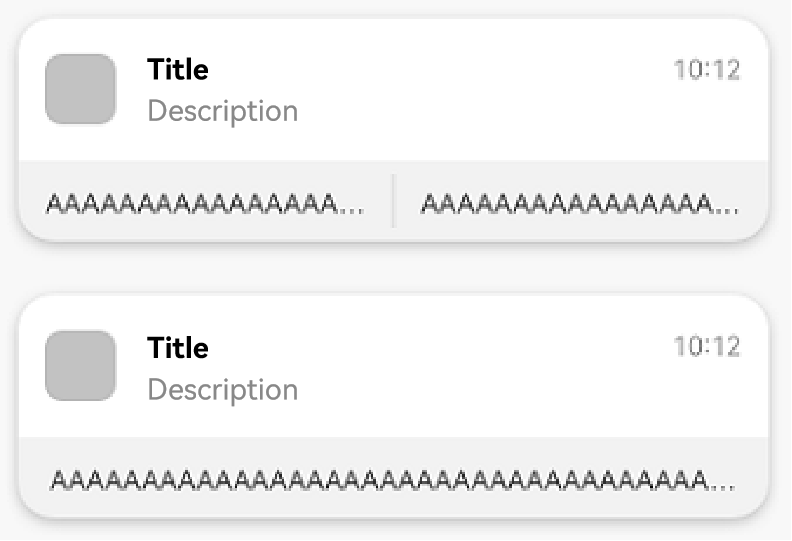harmony 鸿蒙Adding a WantAgent Object to a Notification
Adding a WantAgent Object to a Notification
An application requests WantAgent from Ability Kit and encapsulates it into the notification. When a notification is published, the user may tap a message or a button in the notification panel to start the target application or publish a common event.
The following figure shows a notification carrying action buttons.

Working Principles

Available APIs
| API | Description |
|---|---|
| publish(request: NotificationRequest): Promise<void> | Publishes a notification. |
| getWantAgent(info: WantAgentInfo, callback: AsyncCallback<WantAgent>): void | Creates a WantAgent object. |
How to Develop
- Import the modules.
import { notificationManager } from '@kit.NotificationKit';
import { wantAgent, WantAgent } from '@kit.AbilityKit';
import { BusinessError } from '@kit.BasicServicesKit';
import { hilog } from '@kit.PerformanceAnalysisKit';
const TAG: string = '[PublishOperation]';
const DOMAIN_NUMBER: number = 0xFF00;
- Create a WantAgentInfo object.
Scenario 1: Create a WantAgentInfo object for starting a UIAbility.
let wantAgentObj:WantAgent; // Save the created WantAgent object for completing the trigger operations at a later time.
// Set the action type through operationType of WantAgentInfo.
let wantAgentInfo:wantAgent.WantAgentInfo = {
wants: [
{
deviceId: '',
bundleName: 'com.samples.notification',
abilityName: 'SecondAbility',
action: '',
entities: [],
uri: '',
parameters: {}
}
],
actionType: wantAgent.OperationType.START_ABILITY,
requestCode: 0,
wantAgentFlags:[wantAgent.WantAgentFlags.CONSTANT_FLAG]
};
Scenario 2: Create a WantAgentInfo object for publishing a common event.
let wantAgentObj:WantAgent; // Save the created WantAgent object for completing the trigger operations at a later time.
// Set the action type through operationType of WantAgentInfo.
let wantAgentInfo:wantAgent.WantAgentInfo = {
wants: [
{
action: 'event_name', // Set the action name.
parameters: {},
}
],
actionType: wantAgent.OperationType.SEND_COMMON_EVENT,
requestCode: 0,
wantAgentFlags: [wantAgent.WantAgentFlags.CONSTANT_FLAG],
};
- Call getWantAgent() to create a WantAgent object.
// Create a WantAgent object.
wantAgent.getWantAgent(wantAgentInfo, (err: BusinessError, data:WantAgent) => {
if (err) {
hilog.error(DOMAIN_NUMBER, TAG, `Failed to get want agent. Code is ${err.code}, message is ${err.message}`);
return;
}
hilog.info(DOMAIN_NUMBER, TAG, 'Succeeded in getting want agent.');
wantAgentObj = data;
});
- Create a NotificationRequest object and publish a notification carrying WantAgent.
NOTE
If WantAgent is encapsulated in a notification, WantAgent is triggered when the notification is tapped. If a notification contains action buttons, the buttons are displayed when the notification is tapped and WantAgent is triggered when the notification is tapped again.
If WantAgent is encapsulated in the action buttons, the buttons are displayed under the notification when the notification is tapped and WantAgent is triggered when a button is tapped.
// Create the NotificationActionButton object.
let actionButton: notificationManager.NotificationActionButton = {
title: 'Test_Title',
// Before using wantAgentObj, ensure that a value has been assigned to it (that is, step 3 is performed).
// WantAgent of the notification buttons
wantAgent: wantAgentObj
}
// Create a NotificationRequest object.
let notificationRequest: notificationManager.NotificationRequest = {
content: {
notificationContentType: notificationManager.ContentType.NOTIFICATION_CONTENT_BASIC_TEXT,
normal: {
title: 'Test_Title',
text: 'Test_Text',
additionalText: 'Test_AdditionalText',
},
},
id: 6,
// WantAgent of the notification
wantAgent: wantAgentObj,
// Action buttons
actionButtons: [actionButton],
}
notificationManager.publish(notificationRequest, (err: BusinessError) => {
if (err) {
hilog.error(DOMAIN_NUMBER, TAG, `Failed to publish notification. Code is ${err.code}, message is ${err.message}`);
return;
}
hilog.info(DOMAIN_NUMBER, TAG, 'Succeeded in publishing notification.');
});
你可能感兴趣的鸿蒙文章
harmony 鸿蒙Notification Kit (User Notification Service)
harmony 鸿蒙Publishing a Live View Notification (for System Applications Only)
harmony 鸿蒙Managing the Notification Badge
harmony 鸿蒙Canceling a Notification
harmony 鸿蒙Clearing Repeated Notifications Across Devices
harmony 鸿蒙Cross-Device Notification Management (for System Applications Only)
harmony 鸿蒙Cross-Device Notification Overview
harmony 鸿蒙Requesting Notification Authorization
harmony 鸿蒙Introduction to Notification Kit
harmony 鸿蒙Enabling Quick Reply for Cross-device Notifications
- 所属分类: 后端技术
- 本文标签: